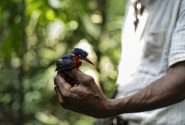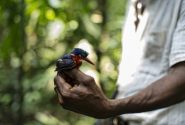By Stephen Leahy

Scientists say biodiversity decline continues during 21st century unless emerging policy choices are pursued. ©CIFOR/Manuel Boissiere
NAGOYA, Japan, Oct 26, 2010 (IPS) – A major change in the direction of economic development is essential to avoid the catastrophic unraveling of Earth’s ecosystems that support all life, a new global analysis published in the journal Science revealed Tuesday.
Climate change, pollution, deforestation and other forms of land use change are pushing species into extinction, reducing their abundance and home ranges.
“Human societies and infrastructures have evolved with and rely on particular sets of species and ecosystems and now these are being reshuffled,” said Paul Leadley of the University Paris-Sud in France who led the study.
“Even optimistic scenarios for this century consistently predict extinctions and shrinking populations of many species,” Leadley told IPS by telephone from France.
The goal of halting the loss of biodiversity by 2020 is under intense negotiation this week in Nagoya at the 10th Conference of the Parties to the Convention on Biological Diversity. However, based on five recent global environmental assessments, Leadley says that ending biodiversity loss by 2020 is sadly “unrealistic”. Leadley and colleague Henrique Miguel Pereira led a 23- member scientific team from nine countries that compared results of recent global environmental assessments and a wide range of peer-reviewed literature examining likely future changes in biodiversity. The analysis found inevitable continuing decline of biodiversity during the 21st century, but offers new hope that it could be slowed if emerging policy choices are pursued.
“Biodiversity” is the term used to describe the wide variety of living things – trees, insects, plants, animals – that comprise the planet’s biological infrastructure and provide us with health, wealth, food, water, fuel and other vital services. Many people fail to understand how dependent humanity is on the many natural services provided by nature and how fast this is changing, Leadley says.
Although there has been a public focus on extinctions, it is changes in species distribution and population sizes that are more critical to human well-being and better short-term indicators of the pressures of humans on ecosystems, the study says.
In the oceans, a combination of climate change resulting from carbon emissions from burning fossil fuels and overfishing are quickly shifting marine life to the point where there will be few large fish left to catch, researchers found. Jellyfish may be the main seafood item on the menu in future, he said.
On land deforestation, conversion of natural landscapes and climate change are transforming landscapes. A recent million-dollar assessment of the Amazon forest discovered that if global temperatures rise two degrees C., as seems likely, the combination of deforestation of roughly 20 percent of the original forest and forest fires will undermine the Amazon’s unique ability to produce half of its own rainfall. Without that rainfall, the rainforest will convert into dry grasslands (cerrado), resulting in massive release of carbon and the loss of many species.
That’s a solid finding, and even if deforestation stops after 20 or 22 percent is gone, the study shows most of the Amazon will be inevitably lost in 50 to 60 years, says tropical biologist Thomas Lovejoy, chief biodiversity adviser to the president of the World Bank and member of the Global Environment Facility science advisory panel.
“Two degrees of warming will be hard on many ecosystems. Tropical forests will be in trouble, there will be few coral reefs left and temperate forests will be very different then they are today,” Lovejoy told IPS in Nagoya.
A solution to cool the planet and save the Amazon is to restore forests and grasslands so they remove carbon from the atmosphere, he said. Economic growth has to shift profiting from land conversion to profiting from restoration.
Tackling climate change can be a game changer for the decline in biodiversity, agrees Leadley. Scenarios show that if a price were put on all forms of carbon, including carbon emitted from deforestation and agriculture, it could go a long way to fixing the problem, he says. Deforestation and agriculture account for 35 to 50 percent of all carbon emissions into the atmosphere. They are also the biggest direct drivers of biodiversity in terms of conversion of natural ecosystems.
A strong carbon tax that both levies a cost for carbon emissions and rewards carbon sequestration, combined with effective protected areas, is what will be needed, Leadley said. Simply protecting 20 percent of the land and 15 percent of the sea as originally proposed as the international 2020 objective by the CBD would not be enough to halt biodiversity loss based on the analysis without action on climate change.
But action must be taken quickly, as the study indicates the window of opportunity is closing rapidly. Differences in policy action taken now could either lead to an increase in global forest cover of about 15 percent in the best case or losses of more than 10 percent in the worst case by 2030.
Getting policy makers to understand these realities remains a major challenge. Scientists hope the creation of an Intergovernmental Panel on Climate Change (IPCC)-like mechanism for biodiversity called the Intergovernmental Platform on Biodiversity and Ecosystem Services (IPBES) will make the difference.
“The issues are so urgent and the stakes for humanity so important, scientists need to coalesce through the IPBES to inform policy-makers with a unified, authoritative voice,” stated Pereira, of the Universidade de Lisboa, Portugal.
Governments here in Nagoya say they are in favour of the creation of IPBES but some are withholding full support as a bargaining chip in the highly contentious debates over Access and Benefit Sharing. While “the nature panel”, as it’s called in the hallways, would have to be formally approved at some future meeting at the U.N. General Assembly, strong endorsement here at COP 10 is considered a necessity to make that happen.
Global biodiversity assessments are extremely hard to do at present and we cannot speak with one voice without an organisation like IPBES, Leadley said.
“I’d like to remind delegates in Nagoya that business-as- usual development pathways will lead to catastrophic biodiversity loss,” he said.
Stephen Leahy is a freelance journalist. He can be contacted at steve.leahy0@gmail.com. Or follow him on Twitter at http://twitter.com/StephenLeahy
We want you to share Forests News content, which is licensed under Creative Commons Attribution-NonCommercial-ShareAlike 4.0 International (CC BY-NC-SA 4.0). This means you are free to redistribute our material for non-commercial purposes. All we ask is that you give Forests News appropriate credit and link to the original Forests News content, indicate if changes were made, and distribute your contributions under the same Creative Commons license. You must notify Forests News if you repost, reprint or reuse our materials by contacting forestsnews@cifor-icraf.org.










